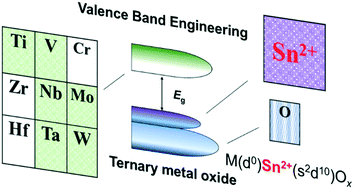State-of-the-art Sn2+-based ternary oxides as photocatalysts for water splitting: electronic structures and optoelectronic properties
Abstract
Developing visible light responsive metal oxide photocatalysts is a challenge that must be conquered to achieve high efficiency for water splitting or hydrogen evolution reactions. Valence band engineering is possible by forming ternary oxides using the combination of a metal cation with an s2d10 electronic configuration and a transition metal oxide with a d0 configuration. Many (Sn2+, Bi3+, Pb2+)-based ternary metal oxide photocatalysts have been reported for hydrogen and/or oxygen evolution under visible irradiation. Sn2+-based materials have attracted particular attention because tin is inexpensive, abundant and more environmentally friendly than lead or bismuth. In this review, we provide a fruitful library for Sn2+-based photocatalysts that have been reported to evolve hydrogen using sacrificial reagents, including SnNb2O6, Sn2Nb2O7, SnTaxNb2−xO6, SnTa2O6, Sn2Ta2O7, SnWO4 (α and β phases), SnSb2O6·nH2O, and Sn2TiO4. The synthesis method used in the literature and the resultant morphology and crystal structure of each compound are discussed. The density functional theory (DFT) calculations of the electronic structure and density of states are provided, and the consequent optoelectronic properties such as band gap, nature of the bandgap, dielectric constant, and effective masses are summarized. This review will help highlight the main challenges for Sn2+-based materials.



 Please wait while we load your content...
Please wait while we load your content...